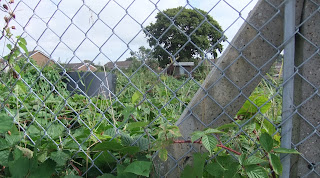Little gems
Near a quiet cemetery in Lake a strange
sight, a gaggle of people milling around a green space next to allotment
grounds, like the tardis, eco-island hub had landed in Lake, what were they
doing? Too many high spirits for it to be a funeral, though some of the people wouldn’t
have looked out of place attending one, suits aplenty even on a hot day. David
Green wearing his ubiquitous smart, but casual cream beach/cocktail, every occasion
attire, and sporting his infamous solar powered grin. But I digress, back to
the photo shoot, where various organisations/representatives were gathered. The
owners of the land have handed over the patch to eco-island to arrange for the
local community to use in growing food etc. Those of us on the fringes were
thrown eco-island t.shirts to wear, (and keep) for the photo shoot, a local
woman walking past grumbled about ‘mainlanders ruining the island’, and ‘my
family can be traced back a thousand years living on this Island’ – she would
probably have had to be rugby tackled, and tranquilised to get her into
an eco-island t.shirt!
The land earmarked for ‘community’ use may appear in
need of some TLC, brambles cover it like a billowing green sail. If only it
were just ripe blackberries to be picked (the fruit is just turning plump and
glossy) but in this case it’s ripe for clearance, who could possibly want it to
stay like this? Perhaps the butterflies, and bees who collect nectar from the
flowers, or the birds that forage amongst the leaves for insects and fruit, or
the mice, squirrels, slow worms, toads and frogs that may be sheltering beneath
its prickly crown. These are one of the few places that the domestic cat and
dog don’t reach, the bed of thorns a deterrent. Brambles are natures larder for
little and large critters. Eco-isle’s Joni Rhodes assured me that an ecological
report will be made of the area by Ian Boyd of Natural Enterprises. But do reports
cover all that happens, all the critters that use this area, surely it can only
be a glimpse on that one day, whereas natures always changing, the burrowing
bees I spotted in Spring aren’t there in August. Like mayflies they may appear
one day and be gone the next. What will be missed?
An interesting conversation ensued
regarding a swathe of pretty flowering plants on the allotment adjoining the newly
acquired ‘community’ patch, the couple working the allotment didn’t know what
it was, but being intrigued, I looked it up, remembering reading somewhere that
this area couldn’t be built on because it was a sight of special, scientific
interest. The allotment couple said they thought a rare orchid growing on the
allotment had saved it from development. After the photo shoot we all went our
separate ways. Online the mystery plants appeared in several different reports,
and checking the image found it was the same ‘Martin’s Ramping Fumitory’, a
nationally rare annual plant, that needs annual cultivation of the ground to
provide the conditions necessary for the seed to germinate.
According to the
English Nature report there are other rare and interesting species of plants on
the allotment. In the few minutes I spent with the allotment couple, a small
toad was spotted, numerous, unusual looking black and white striped bees
collecting nectar from the MRF plants, an Adonis blue butterfly amongst the
wildflowers, and past regular spottings of slow worms, we disturbed a sinister
shape amongst the dried grass, to find a local moggy’s sunbathing spot. Who
knows what other wonders may be lurking around these precious patches. How will
the community react to a 'gift’ of land
that they may have to manage?



No comments:
Post a Comment